Special Offering Yamabushi Alchemical Jewel Treasure Mikkyō Bead
Special Offering is for 1 (one) bead. Each bead measures approximately 10mm and comes strung on blue cord as pictured.
Yamabushi Alchemical Jewel Treasure Mikkyō Bead or Hoju (Wish Fullfilling Gem also called the houshu /Hoju/flaming jewel/Cintamani)
Few are aware of the core of the alchemical tradition within Buddhism. In both esoteric and exoteric Buddhist traditions from Tantrik to Theravada, there is a core understanding of this as both medicine and spiritual technology. It is a science of metal, minerals and herbs that traces to ancient Indo-European migrations that brought this core teaching and skillful method. There are special alchemical medicines of India like amrita and muppu, there are special rasashastra of bhasma and elixirs. There are the tonics and magical plates, bowls and cups of India and especially of Daoist cults. There are navapashanam of mahasiddha, jewel and precious pills of Tibetan traditions. There are masters of mercury beads in Burma and Thailand, in Malaysia and Vietnam. This extends into Korea and Japan as well. Here we focus on an alchemical secret practice from Japanese Buddhism, mikkyō (密教, from himitsu bukkyō, literally “secret Buddhism”) or Japanese Esoteric Buddhism, is the lineage of Vajrayana transmitted to Japan, primarily in the early Heian by Kūkai, and to a later extent by Saichō and his successors such as Ennin.
We present here a very rare type of alchemical bead worn for protection and dipped into water as a sacred healing tonic much like navapashanam. It is considered a high secret, a magical energetic electrum composed of alchemically purified metals and meteorite into an profound spiritual tool and talisman. These are compounded with lunar timing, as the immortal drugs is compounded on the moon. It is made in secret caves and using mountain springs and ores of old ancient mines, these are the lineage holding methods of empowering by touch of traditions that date to Kukai. Japanese esoteric Buddhism is supreme and yet the hardest to penetrate. It has been infiltrated in modern times by anti-Traditions who cater to tourists and a rich elite who use it only as custom for marriages and funerals. Most have given up on becoming “Buddha in this very lifetime” as Kukai told is the Great Work. This is thus a guarded limited secret of Shugendo, a demon dispersing treasure gem that shatters obstacles on the path, removes sin, banishes hungry ghosts, parasitic demons and aids in gaining Siddhis. Truly these teachings are only found in the oral traditions (Jp. kuden) of ryu, the inner teachings (Jp. gokui).
The internal effects of the elixir water from the bead is in increasing vital energy in the cinnabar field. This is because it is related to the mountain goddess of the Yamabushi that dates back to the Shingon founder Kukai. We quote, “Niutsuhime Myoujin 丹生都比売明神. A female mountain deity that resides in Mt. Kouya 高野. According to legend *Kuukai 空海 (774-835, see *Koubou Daishi 弘法大師) received permission from Nui Myoujin through an oracle to build Kongoubuji 金剛峯寺, his monastery on Mt. Kouya, in 816. In many variants of the legend Nui Myoujin’s son (or emanation) *Kariba Myoujin 狩場明神 (also known as Kouya Myoujin 高野明神) appeared as a hunter who led Kuukai to the site. Nui Myoujin and Kariba Myoujin were adopted as the guardians chinju 鎮守 of the monastery and, with two other deities added later, were worshipped at the Amano Jinja 天野神社, presently Niutsuhime Jinja 丹生都比売神社, as Kouya Shisho Gongen 高野四所権現 or Kouya Shisha Myoujin 高野四社明神. The word niu is found in the names of places associated with the mining of mercury ore (cinnabar). Scholars suggest that Niu Myojin may have been the deity of clans who did such mining. Mt. Kouya has, for the purposes of mandalas, sixteen peaks, which are represented as eight inner and eight outer petals, and these works combine the Matrix Mandala *Taizoukai mandara 胎蔵界曼荼羅 and Diamond World Mandala *Kongoukai mandara 金剛界曼荼羅. These last two are the diagrams of the two aspects of *Dainichi 大日 representing the realms of dynamic enlightenment and wisdom respectively. The bonji 梵字 (Siddham letters that are the sound symbol of the deity) for these two forms of Dainichi may appear on paintings of Nui Myoujin and her son when they are represented as Shinto deities *kami 神.
of Niu Myoujin and her son when they are represented as Shinto deities *kami 神.
As her name says, 丹を生む, she is giving birth to cinnabar. She is related to cinnabar (shu 丹) and then mercury, which was found in the land around Koyasan. When Kukai received the land for building his temple, the natural resources would provide the money for construction of the many temples. The vermillion bridge and shrine buildings in her honor may relate to the cinnabar. The main statue of the shrine in her honor might well be a piece of cinnabar crystal, which melts into mercury (cinnabar (mercuric sulfide, ryuuka suigin 硫化水銀). It is a secret statue which nobody has seen yet.
In the Chinese alchemical traditions of Tao, mercury represents the yin principle embedded in yang; mercury is extracted and added to sulphur (yang, cinnabar).
This is a bead that is partaking of this mysterious nature of purified alchemical medicines and astral meteorites.
Likewise, the shards of meteorite are said to be from a sacred event:
“the celestial dog/shooting star of the Nihon Shoki, Mao-son is a meteorite (or part thereof) but, according to Kurama-kokyo, it was 6,500,000 years ago that he came to earth from the planet Venus to live at Mt. Kurama. The remains of the meteoroid came to be housed as ‘Mao-son’ in a small shrine, called the ‘Okunoin Mao-den’, high on the mountain. Believed to be the deity responsible for the creation and destruction of the earth, the kami’s spirit, Goho-mao-son, is said to reside in the old cryptomeria next to the shrine, underscoring the fact that the tengu continue to remain a vital part of Japanese religious tradition associated with mountains.”
This is done by adamantine energetic enhancement through elixir and tonic herbs and special power items. This bead is both, in enabling to create power elixirs and to protect the bodies field of qi. It is a concentrated expression of the core of Esoteric Buddhism which is to be aimed in one’s pursuit with complete and total thought, mind and action. This is the fierceness, the mastery, the authority asserted within that is true mastery. This is why the true esoteric master learn provisional methods and skillful means from Buddhist masters then retreat to the mountains. There they test with the elements of wind in exposing their bodies to mountain winds of brutal frost and ice. They test in fire, the heat of ritual fires surrounding their meditation, the sun scorching them in yogic ascetism. They hang in trees and hide in caves to test the elements of earth and chthonic energies, and stand in frigid waterfalls to embrace and know the element of Water as few can. One becomes whole, enlightened with Memory of True Self, past, present and future, as the Buddha that has been, is Becoming and Will Be in what Kukai called the “Eternal Meditation.” This is the essence of the
Shingon (“True Word”)
To walk with these beads, to enter the mountains in ritual retreats, fasting, testing the body, engaged in the walking asceticism” (kaihogyo) and other methods of Shugendo (Shugenja or Yamabushi literally “those who lay in the mountains”) and to engage the mantra is to connect and be established in this lineage through esoteric empowerments through touch, taste (in the elixir water), in the actions associated such as 108 prostration sets over 108 with the mantra (below). These are fully engaging processes that bring alchemical prophetic dreams, in visions of Buddha, and when combined with the holy herbs there is a true transmutation of essential Self “in this very body, in this very lifetime” as Kukai implores us to engage with all our full mind, speech and deed.
We use these practices and empowering items as part of coure empowerments in the Mountain and Forest Dharma which claims direct transmission from these sects. As we quote, “The arduous discipline (Jp. shugyo) includes solitary confinement in caves, fasting, abstaining from drinking water, sleep deprivation, meditational practices in combination with breathing techniques and the recitation of mantras, the practice of ‘becoming a buddha in this very body’ (sokushin jobutsu) as well as mastery of the cold (Jp. samugyo; such as immersion in icy cold water), fire (Jp. goma; which includes fire-walking, hiwatari), and sharp swords (Jp. hawatari; climbing the sword ladder)” and many other practices designed to create vital energy and train the mind to retain essential mind and memory within the extremes in preparation for the final encounter of death that is the supreme initiation and Immortal Ascension or falling descent into hells and endless rebirths if one fails.
These are trainings to endure death itself, to master dreams, to master pain, ecstasy, fear, deprivation, all of which will attempt to dissolve the True Self upon death. The alchemical method is to build a subtle body, to nourish it with a vital energy and fix its volatile (dream like or mercurial nature) into pure form, purged of toxic dissipations, distractions and dissolution. These beads, like parad gutika and various other alchemical products, are a repository, like a battery that stores intention, that is a witness to the Gods and Buddhas of supreme upward striving and effort, and a potentiating catalyst for meditation, retreats, healing and visionary rituals. It is a constant companion, infusing and melding with the sweat, atoms and form of the wearer. It becomes a guru, a guide, a healing force that is ever-present, and can be a legacy for ancestors, a holy physical form of Buddha Mind expressed over a lifetime. It is a cosmic encoding of the Great Work, of the Dharma, of the Way of the Gods in its elaborte materials and processes containing the essences of the nine planets and realms, the 108 soma herbs, the four elements and the Three Treasures.
The mantra of this jewel bead is
Mani Hoju Mandara Zushi E
摩尼宝珠曼荼羅厨子絵 Mandala of the Mani hoju, the Jewel that Removes Misfortune
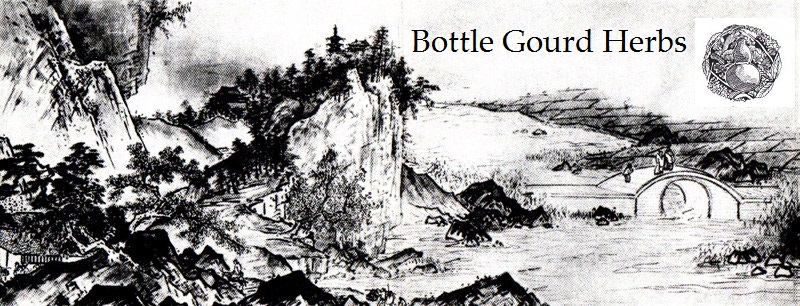
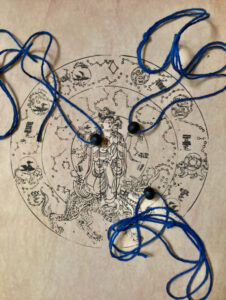
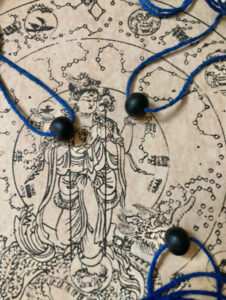
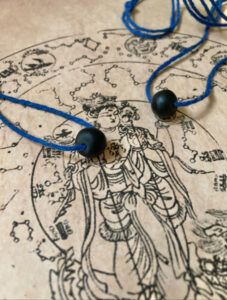
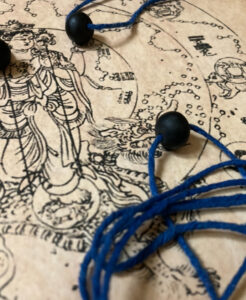
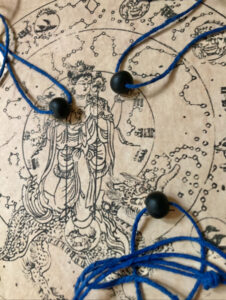
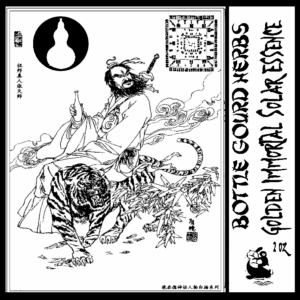
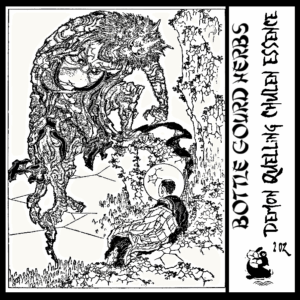
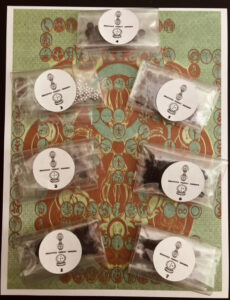
 Adding...
Adding...